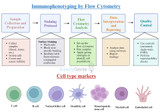Blog
Immunophenotyping by Flow Cytometry and Cell Type Markers
Immunophenotyping by Flow Cytometry Immunophenotyping is a technique used in the field of immunology and cell biology to identify and classify cells based on the specific proteins or molecules found on their surfaces, known as cell surface markers or antigens. These markers provide valuable information about the type, state, and characteristics of individual cells within a larger population. Immunophenotyping is particularly important in fields such as immunology, hematology, oncology, and infectious diseases, where understanding cell populations and their properties is crucial. The primary tool used for immunophenotyping is flow cytometry, although other methods like immu
…
23rd Aug 2023
Oxidative Stress: Causes, Biomarkers & Disease
Oxidative Stress Definition
Oxidative stress is a condition that results when the body produces or consumes more reactive oxygen species (ROS) than it can neutralize. ROS are unstable molecules that can damage cells, proteins, and DNA. Oxidative stress has been implicated in a wide range of diseases, including heart disease, cancer, Alzheimer's disease, and Parkinson's disease. In this article, we will discuss oxidative stress and explore its role in disease. We will also look at some of the most common oxidative stress markers.
Oxidants and reductants can be formed in cells by losing or gaining a single electron, which
…
23rd Aug 2023
Understanding Bone Resorption: Key Definitions and Processes
Unravel the complexities of bone resorption, a crucial biological process essential for skeletal health and calcium regulation, through the intricate roles of osteoclasts and osteoblasts. Key Takeaways Bone resorption is essential for maintaining skeletal health and calcium balance. Osteoclasts dissolve bone tissue, and osteoblasts create new bone, forming a continuous cycle called bone remodeling. Imbalance in bone resorption can lead to conditions like osteoporosis, hyperparathyroidism, or osteopetrosis. Subperiosteal resorption can indicate systemic diseases, particularly hyperparathyroidism. Calcium, stored in bone as hydroxyapatite crystals, plays a vital role in bone res
…
29th May 2023
What Causes Acute Pancreatitis?
Acute pancreatitis (AP) is a condition in which activated enzymes and inflammatory mediators released from the pancreas cause damage to the pancreas and surrounding tissues. AP is further divided into two main categories, a mild form called interstitial oedematous pancreatitis or a severe form called necrotising pancreatitis. Interstitial oedematous pancreatitis accounts for 80% of AP cases and the pancreatic inflammation involved usually resolves itself. However, necrotising pancreatitis resembles necrosis of the pancreas which can result in further complications.
AP starts with inflammation which can lead to damage of affected organs through multiple organ failure (MOF) and
…
15th Feb 2022
Fenofibrate Usage for Diabetes Damage
Fenofibrate, also known as FEN, is a drug that is used to lower cholesterol levels. It works by blocking the absorption of dietary cholesterol in the small intestine and therefore, reduces the amount of cholesterol that enters the bloodstream. Fenofibrate has been shown to be effective in reducing LDL (bad) cholesterol levels by up to 20% and it is approved for use in the United States and Europe. Fenofibrate is a safe and effective drug and it can be used in conjunction with other medications to help reduce LDL levels.
The mechanism of action of fenofibrate is not fully understood, but it is believed to work by inhibiting the activity of a protein called Niemann-Pick C1-Like
…
15th Feb 2022
Cyclophosphamide Side Effects
Ovarian cancer is a set of malignancies that start in the ovaries, as well as adjacent portions of the fallopian tubes and peritoneum. Women have two ovaries, one on each side of the uterus. The ovaries produce reproductive hormones and egg cells. Thousands of women each year get an ovarian cancer diagnosis and this type of cancer ranks fifth in cancer deaths among women.
Cyclophosphamide is an effective alkylating chemotherapy agent used to treat ovarian cancer. Although cyclophosphamide has many benefits cyclophosphamide-induced ovarian toxicity is a side effect of treatment with this drug. This type of toxicity can cause infertility and increase the risk of developing can
…
15th Feb 2022
Everything You Need to Know About Preeclampsia: A Guide
Preeclampsia is a serious condition that can develop during pregnancy. It is marked by high blood pressure and the presence of protein in the urine and can cause serious problems for both mother and baby if it is not treated. A recent study found that preeclampsia is associated with an increased risk of heart disease in later life. It can lead to high blood pressure and diabetes, which both increase the risk of cardiovascular disease. It may also cause damage to arteries and reduce blood flow to the placenta (leading to low birth weight). Therefore, it’s essential that pregnant women should be screened for preeclampsia at their first prenatal visit so that treatment can
…
9th Feb 2022
CD33 Marker
Introduction Discover the multifaceted role of CD33, a critical player in immune function and disease, shaping our approach to treating cancers and neurodegenerative conditions. Key Takeaways CD33, a key glycoprotein in immune responses, is crucial in cancer, especially AML, and neurodegenerative diseases like Alzheimer's. It serves as a therapeutic target, offering avenues for innovative treatments. What is CD33? CD33 is a transmembrane glycoprotein belonging to the sialic acid-binding immunoglobulin-like lectin (Siglec) family. Siglecs are a group of cell surface receptors involved in cell-cell interactions and immune responses. CD33
…
21st Jan 2022



